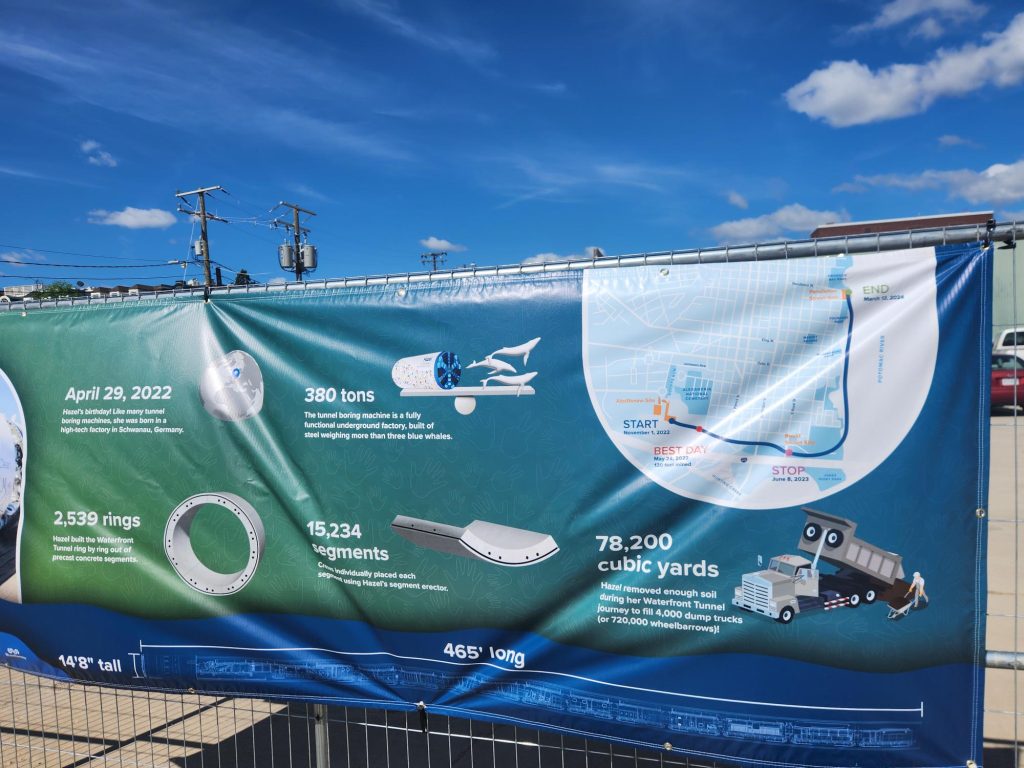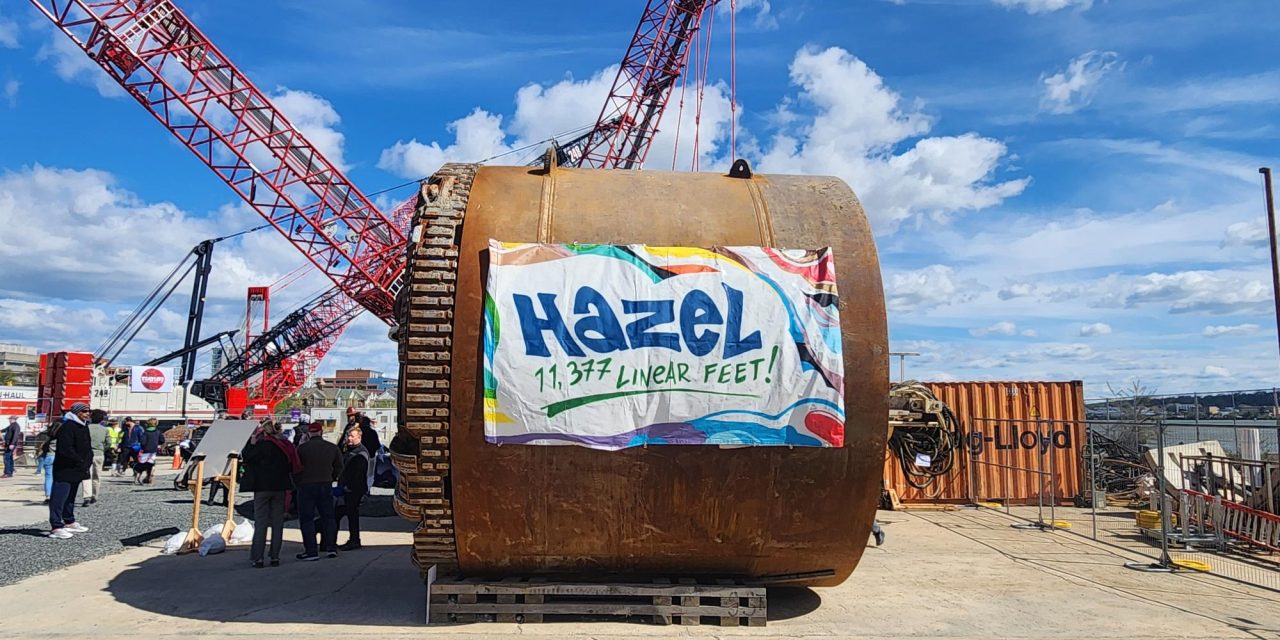Marking a milestone in Alexandria, Virginia’s long-term campaign against chronic combined sewer overflows (CSOs), wastewater utility AlexRenew finished digging its 3.5-km (2.2-mi) Waterfront Tunnel on March 21.
The new tunnel — a centerpiece of the city’s USD $615 million RiverRenew project — promises to drastically reduce the frequency of CSO events affecting its historic district along the Potomac River. It will protect people and property along the waterfront while keeping more than 380 million L (100 million gal) of runoff and untreated wastewater per year out of the Potomac River and Chesapeake Bay, according to AlexRenew.
Instrumental to the Waterfront Tunnel’s completion was a 345,000-kg (760,000-lb) tunnel-boring machine named Hazel, which worked about 30 m (100 ft) beneath the city beginning in November 2022. Justin Carl, AlexRenew General Manager and CEO, said that Hazel’s moniker honors legendary activist Hazel Johnson, often called the “mother of the environmental justice movement.” In the late 1970s, Johnson led efforts in Chicago to illuminate the disproportionate impacts of pollution on the city’s most vulnerable residents, including threats to public health associated with inadequate control of CSOs.
“While Hazel is just a machine, she has embodied the heart and grit of our team, and like her namesake, has set a foundation for a healthier environment for our community, wildlife, and future generations,” Carl said.
Waterfront Tunnel Protects Potomac River
Spanning 4 m (12 ft) in diameter and lined with more than 2,500 concrete rings, the Waterfront Tunnel connects AlexRenew’s water resource recovery facility (WRRF) with the city’s four existing combined sewer outfalls, which have functioned independently since their construction in the 1860s. The roughly 492 million-L (130 million-gal) tunnel will work in tandem with these outfalls as well as a 30-m (100-ft) shaft, originally drilled to lower Hazel underground, that will remain open to pool floodwaters into the new conveyance system. During heavy storms, the Waterfront Tunnel will direct would-be CSOs to the WRRF for treatment before discharge into the Potomac River.

Drilling a tunnel of this scale required similarly colossal machinery. Hazel measures approximately 140 m (465 ft) in length and weighs more than two commercial airplanes. However, displacing the roughly 60,000 m3 (78,200 yd3) of dirt required for the Waterfront Tunnel demanded a long timeline — even for a machine commanding as much force as Hazel. The drill’s massive cutterhead carved through the earth at about 4.5 revolutions per minute, allowing Hazel to proceed at a slow-but-steady pace of about 100 mm (4 in.) each minute.
Sourced from Schwanau, Germany, Hazel made a journey to Alexandria that was as much of an undertaking as her underground campaign. The size of the tunnel-boring machine made it impractical to transport via aircraft, which meant Hazel had to travel by cargo ship up Germany’s Rhine River, across the Atlantic Ocean, and into the Chesapeake Bay. Hazel’s voyage faced unforeseen delays in late 2022 when an outbreak of COVID-19 disrupted work at the German facility in which she was manufactured, and again when the ongoing war in Ukraine caused supply chain issues.
At the conclusion of Hazel’s work, the Alexandria City Council designated April 13 as Hazel the Tunnel Boring Machine Day in recognition of the gigantic drill’s contributions to local water quality.
“The collective efforts of our team to achieve this momentous milestone are nothing short of awe-inspiring,” Carl said. “Their dedication and perseverance pave the way for a brighter future for the Potomac River.”
RiverRenew Flows Forward
With work completed on the Waterfront Tunnel, AlexRenew now is turning to the remaining components of its RiverRenew project — considered the largest infrastructure initiative in Alexandria’s nearly 300-year history.
Still to be constructed are a new sewer interceptor as well as a series of shafts to aid in redirecting potential floodwaters from streets into the RiverRenew system. The utility also is building a pumping station “superstructure.” This unique complex will extend approximately 12 stories beneath the surface but also will serve as a public amenity aboveground. Elements of the pumping station’s construction include educational signage, an urban garden, a green roof, and an extensive solar panel array.

Prior to RiverRenew, the utility estimates that CSOs would occur in Old Town, Alexandria, after the city experienced as little as 0.6 cm (0.25 in) of rain in a single event. Alexandria experienced sufficient rainfall to generate CSOs approximately 70 times each year, spilling roughly 530 million L (140 million gal) of untreated wastewater annually into the Potomac River and its tributaries. Upon its completion, which is expected next summer, the RiverRenew project will minimize this frequency to fewer than four CSO events per year, according to AlexRenew estimates, discharging less than 64 million L (17 million gal) per year into local waterways during only the most severe storms.
Much of RiverRenew’s costs are funded by state and federal grants and loan programs. For example, the project secured a $321 million loan from the U.S. Environmental Protection Agency’s Water Infrastructure Finance and Innovation Act (WIFIA) program in 2021, which minimized effects on the city’s ratepayers. AlexRenew estimates that WIFIA’s low interest rates limit increases to the average monthly utility bill to about $5 — compared to approximately $40 projected if that amount was funded via market-based loans. RiverRenew also benefits from a $25 million grant from the Virginia General Assembly, awarded in 2019.
Learn more about RiverRenew at the project’s website.
Top image courtesy of Suzanne Shutty/Water Environment Federation

ABOUT THE AUTHOR
Justin Jacques is editor of Stormwater Report and a staff member of the Water Environment Federation (WEF). In addition to writing for WEF’s online publications, he also contributes to Water Environment & Technology magazine. Contact him at jjacques@wef.org.






